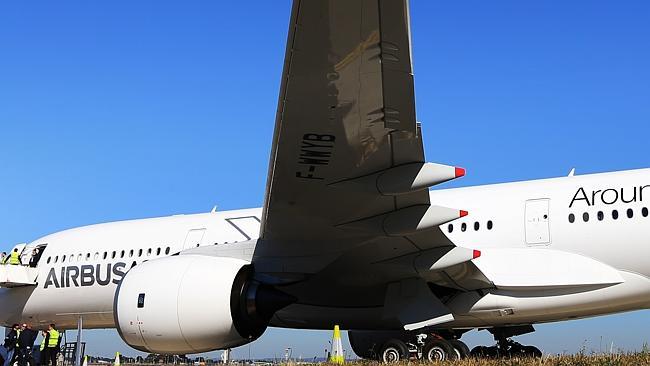Airbus A350 a dream liner, says Borghetti
AIRBUS appears to have gained a boost in its competition to win an order with Virgin Australia.

AIRBUS appears to have gained a boost in its competition to win an order with Virgin Australia, the airline indicating the new A350 is a contender for its next generation of planes, along with Boeing’s 787.
The all-new widebody aircraft was in Sydney yesterday as part of a global route-proving tour, and after a tyre-kicking walk-through Virgin Australia chief executive John Borghetti labelled the plane “seriously outstanding”.
Mr Borghetti said Virgin would have to make a decision between the two hi-tech aircraft, but “there’s no rush for that”.
“We’ll take our time and make sure we make the right decision, but this (A350) is a very impressive aircraft,” he said.
There was a timeframe for a decision, but he would not reveal what it was.
“Our team’s been studying this very carefully, obviously, along with the Boeing aircraft, and from everything we’ve seen on paper certainly (the A350’s) an incredibly competitive aircraft.
“Whether you’re looking at it from the operating statistics or the customer comfort, I have to say that I have been pleasantly surprised.”
After walking through the aircraft, Mr Borghetti said he was impressed by the spaciousness of the cabin.
“You really don’t think you’re in a tube; you think you’re in a room because you’ve got a flat roof and almost a flat side.
“It’s very different to what was, of course, the original 350 design. This is outstanding, seriously outstanding.”
The tour has seen Airbus test aircraft MSN005, an A350-900, on flying conditions to cities around the world to complete certification requirements.
Certification of the new aircraft is expected in the third quarter, with entry into service with Qatar Airways in the fourth quarter.
Like the rival Boeing 787 Dreamliner, the A350XWB uses carbon composite and other advanced materials to reduce weight and boost fuel efficiency. About 53 per cent of the plane is composite, but instead of spinning entire sections of fuselage, as Boeing does, Airbus has attached the carbon-fibre reinforced plastic as panels.
The European manufacturer says the weight reduction will combine with aerodynamic improvements and new engines to lower operating costs by 25 per cent compared with older, equivalent planes.
The A350-900 can fly up to 7750 nautical miles in a typical two-class configuration offering 315 seats.
Airbus heavily promotes the ability of the aircraft’s bigger 220-inch (559cm) fuselage to allow airlines to install wider seats. The efficient Rolls-Royce Trent XWB engines and the aerodynamic tweaks on the plane mean the cabin is significantly quieter than traditional aircraft.
And while the windows are not as big as the 787s there is a sense of spaciousness.
The company has yet to sell the A350 in Australasia, but it remains optimistic about its prospects, despite Boeing’s success with the 787 at Qantas and Air New Zealand.
It has a bigger version of the plane with more powerful engines due to enter service in 2017. The A350-1000 will be able to carry 369 passengers in two classes 250nm further than the A350-900.
Boeing and Airbus have both introduced all-new aircraft in the past eight years, but the manufacturers will be busy working on derivatives of existing planes for the foreseeable future.
These include new members of A320 and A330 families at Airbus and derivatives of the B777, B787 and B737 at Boeing.


